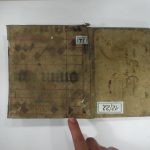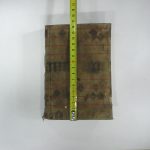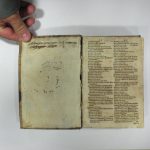Fragment of the Antiphonale Varadinense („Zalka” Antiphonal).
The library of the Franciscan convent in Güssing (Austria) preserves two fragments in situ, presumably originating from the famous family of late medieval luxurious choirbooks – both for the Mass and the Office – of the Várad (Oradea in present-day Romania) cathedral. The fragments cover the books with the shelfmarks 12/22 and 10/33. Chant scholars in Hungary have known about both for a long time: based on their codicological and palaeographic characteristics, Janka Szendrei assumed already in 1981 that they were fragments of the Várad codices (see Bibliography).
However, the liturgical-musical material preserved on the fragments is so scarce that attempts to define it – and thus identify the genre of the mother codex – proved fruitless for a long time. While the content of the fragment covering the carrier 10/33 remains uncertain (and consequently, it is impossible to know what genre the mother codex belonged to), we were recently able to identify the fragment serving as the binding of 12/22. The carrier book is an incomplete copy of Petrus Dasypodius’s Latin-German dictionary printed 1537 in Strassburg. The chant preserved on the fragment could be identified as the torso of the responsory Ave Maria sung in the Matins of the first Sunday in Advent, thus clarifying the question of the genre of the original manuscript: the fragment belonged to the Várad Antiphonal. The main corpus of the manuscript – restored in 1872 – is kept in the Diocesan Treasury and Library in Győr, however, a large number of its fragments are preserved in collections in Hungary and abroad (see more in the facsimile edition with essays written by Zsuzsa Czagány, Antiphonale Varadinense saec. XV, vol. I. Proprium de tempore, vol. II. Proprium de sanctis, vol. III. Tanulmányok / Essays, Musicalia Danubiana 26/1–3, Budapest, Research Centre for the Humanities, Institute for Musicology, 2019).
The Güssing fragment fits well with the group of fragments found in Modra (Slovakia) containing predominantly chants for the Advent Offices, especially those for the First Sunday. Regarding its content the Güssing fragment is particularly closely related to one of the Modra fragments (Štátny archív Bratislava, pobočka Modra sign. 3120, M3 in the edition of Zs. Czagány): both contain successive parts of the responsory Ave Maria of the second nocturn of Matins. Therefore, the two folios certainly followed each other at the very beginning of the first volume of the Várad Antiphoner.
Zsuzsa Czagány




